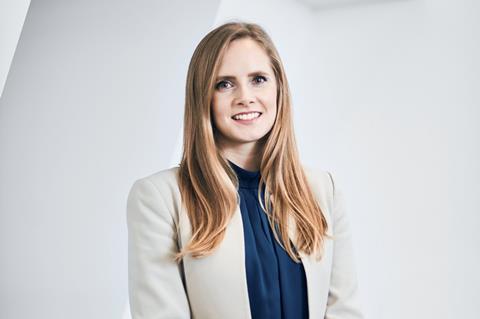Claire Gott is a mother to a two-year-old and runs a 500-employee business. She tells Dave Rogers how she makes it work ŌĆō and what the industry can do better

WSPŌĆÖs head of building structures thinks for a minute and then says: ŌĆ£If IŌĆÖm being brutally honest, itŌĆÖs not where my strength was.ŌĆØ
Claire Gott is mulling whether she misses being an engineer. She has been at the firm since she graduated from Southampton University with a civil engineering and architecture degree in 2010.
She loved being an engineer but, in the time since joining the Canadian-owned business 15 years ago, she has moved far away from her initial job as a graduate on the Alder Hey childrenŌĆÖs hospital in Liverpool.
She is now running the firmŌĆÖs 500-strong structures business, which is working on a slew of high-profile projects such as the new HS2 station at Curzon Street, the planned tallest tower in the City, 1 Undershaft, and a huge research and development scheme which Laing OŌĆÖRourke is building in Oxford called the Ellison Institute of Technology.
Designed by Foster + Partners, it is being bankrolled by an 80-year-old US billionaire called Lawrence J Ellison, better known as Larry, who is the co-founder of the US tech giant Oracle Corporation. He rubs shoulders with US president Donald Trump and is the worldŌĆÖs fourth-richest man with an estimated fortune of around $187bn (┬Ż141bn) according to Forbes.
ŌĆ£I love doing the people side of the job, being engaged with clients, Gott says of her moves away from being an-on-the ground engineer. ŌĆ£ItŌĆÖs just an acknowledgement of where your skillsets are and I acknowledged that quite early.ŌĆØ
It is hard. I do still think we have got a way to go to be equal in how we [the industry] approach our workforce
She will have been in charge of the structures division for a year in July, replacing predecessor Jane Richards who has been reducing her hours in the lead up to retirement. Of her current post, Gott says: ŌĆ£I donŌĆÖt take it lightly, itŌĆÖs a big role.ŌĆØ
The 36-year-old has progressively taken on more senior positions as her career at WSP has developed. She has been head of its industry business and before that was in charge of its corporate social responsibility.
She began her switch into building structures when she came back from maternity leave at the end of 2022 having had her son, Louis, now aged two and a half. ŌĆ£IŌĆÖm not going to lie, it is a juggle,ŌĆØ she says of balancing work and life.
ŌĆ£It is hard. I do still think we have got a way to go to be equal in how we [the industry] approach our workforce.ŌĆØ
Every Monday and Friday afternoon, she picks up Louis from nursery in Cheltenham, where she and husband James live. From that time, around 3.30pm, she will spend the rest of the day with him until he goes to bed. ŌĆ£If I need to make up the hours, I will.ŌĆØ

Her husband, a commercial property developer, puts in his hours as well but, given the demands of their jobs, the pair have to plan. ŌĆ£We really have to make sure we structure our week and map it out very carefully.
ŌĆ£There are some things that we [women] do, that men canŌĆÖt do. We have to have the children and so we [the industry] have to find ways around that and to accommodate that to better enable careers to flourish.ŌĆØ
>> Also read: 5 minutes with Claire Gott at WSP
Gott tends to split her time between Cheltenham, WSPŌĆÖs head office on LondonŌĆÖs Chancery Lane, and Birmingham. In all, the firm has 20 offices dotted across the UK, with structures operating out of a dozen of them.
WSP is partnering with Arcadis on the design of Curzon Street and Gott thinks the industry needs to do more of it. ŌĆ£We share the risk and the reward, we have the benefit of sharing our people, which means more resilience,ŌĆØ she says.
ŌĆ£These are big projects and sharing best practice goes alongside innovation and it enables a better approach in the supply chain.ŌĆØ
She thinks that too many shy away from joint ventures or partnerships ŌĆō call them what you like ŌĆō because it might be seen as giving the opposition an advantage. ŌĆ£You have to take a leap of faith. If weŌĆÖre too narrow-minded, weŌĆÖre never going to grow as an industry.ŌĆØ
She also worries that time and cost pressures mean graduates will miss out on shadowing their more experienced colleagues and so lose picking up precious skills and tips that university course work will never teach.
>> See also: In pictures: Fosters reveals new images of Oxford R&D campus to be built by Laing OŌĆÖRourke
>> See also: In pictures: Laing OŌĆÖRourkeŌĆÖs Alder Hey hospital opens
After leaving the Alder Hey job, she moved on to the redevelopment of London Bridge station, a mammoth task which involved turning a pretty grotty travel experience for many into something much better. The station has been transformed, both as a transport interchange and somewhere to loiter rather than hurry through and, frankly, get the hell out of.
It was built over nine stages. ŌĆ£I did six months of shadowing when I first joined,ŌĆØ Gott says. ŌĆ£We donŌĆÖt do enough of that in the industry anymore.
ŌĆ£You want people who have the skills now but the only way to keep developing the next generation is by offloading some of that knowledge that some of our really experienced individuals have.ŌĆØ
Claire GottŌĆÖs career so far
2006-10 Southampton University, MEng civil engineering and architecture
2007-10 Costain, undergraduate engineer
2010-13 WSP, Structural engineer
2013-15 WSP, design package manager, London Bridge station
2015-19 WSP, design manager
2017-22 WSP, UK head of CSR
2019-24 WSP, head of industry
2023-24 WSP, deputy head of structures
2024-present WSP, head of structures
The revival of London Bridge, she says, ŌĆ£has transformed the whole community ŌĆ” ThatŌĆÖs why IŌĆÖm excited to see what happens when HS2 opens because the transformation locally is the bit weŌĆÖre all going to fall in love with.ŌĆØ
She was working on the HS2 station plan at Euston several years ago, trying to bring it into a budget with which politicians would be happy. But it has now been on ice for more than two years, with London-bound trains due to terminate at Old Oak Common, in the west, where WSP is also working.
ŌĆ£Fingers crossed,ŌĆØ she says diplomatically when asked if Euston ŌĆō as it surely must ŌĆō will eventually get built.
>> See also: Why women are over mentored and under promoted
Her role on London Bridge also saw her get involved with design management and her architecture degree, which saw her complete her part I, has helped to give her an all-round view of the construction process.
ŌĆ£It has enabled me to see things more holistically and to be able to understand the impacts that the design decisions make on different disciplines. With design management, you can see the impact of a decision right at the start.ŌĆØ
At London Bridge she saw the benefit of offsite manufacture with components, such as cassette systems, brought in already pre-wired. ŌĆ£Fire, communications, VT ŌĆō all that was connected and then plugged in. It saved a huge amount off the programme.ŌĆØ
She says WSP is developing something called a kit of parts which will reduce transportation and storage and help with the ability to work on confined sites. ŌĆ£WeŌĆÖre setting up factories that build the components and it makes assembly so much quicker.ŌĆØ
Gott says the initiative is taking hold on the Ellison Oxford job, where thousands of components are being built offsite ahead of being fitted. ŌĆ£It allows for more efficient designs and solutions. It gives our designers more time to focus on areas where we can add real value. The basic elements can be done through a kit of parts.ŌĆØ

Gott is also involved with the Circle Partnership, whose mission statement is this: ŌĆ£We are taking practical action to change the long-term composition, culture and capacity of the built environment, through improving mid-level female talent retention and increasing gender balance at senior leadership level.ŌĆØ
She goes back to her university and old school in Worcester to give talks about how girls and young women can get into the industry. ŌĆ£If I had been able to see another woman broadly in an age bracket that I could relate to [when I was at school], that can make a massive difference.ŌĆØ
WSP has a 50:50 split between men and women at graduate intake level but Gott admits that it will be a slow burn to see more women in senior leadership roles. ŌĆ£It will take time to work through,ŌĆØ she says. ŌĆ£There is a lot of work to do about changing perceptions and it wonŌĆÖt happen overnight.ŌĆØ
Gott went into engineering ŌĆ£to make a differenceŌĆØ. She tells the story that quite a few of her peers on her course at Southampton ended up eschewing the discipline for a career in finance instead.
ŌĆ£So many of my cohort went into banking,ŌĆØ she says, ŌĆ£partly because they knew that, if they thrashed themselves for 10 or 15 years, they could retire early and partly because there was a perception around opportunities at that time. We do still have to keep fighting for people to come into the industry.ŌĆØ
The ŌĆśprankŌĆÖ that turned out to be real
Some people might already know that Claire Gott has an MBE for services to charity and civil engineering. It is all to do with an engineering-led charity she set up in 2009 when at university called Cameroon Catalyst.
The charityŌĆÖs goal is to help one village at a time in east Cameroon through community-led infrastructure development projects that progressively transform peopleŌĆÖs lives.
Over the years, 250 students, partners and trustees have become involved with it and there are student chapters at Southampton, Imperial and Birmingham universities.
Gott was awarded the gong in 2015 but, if that is old news for some, how she was told about the honour might be more of a revelation. ŌĆ£It took them months to track me down,ŌĆØ she says.

The whole honours process is shrouded in secrecy. Buckingham Palace would call up, ask for Claire Gott, not get hold of her and so not leave a message.
The mystery caller thing went on and on. ŌĆ£They couldnŌĆÖt get hold of me. They wouldnŌĆÖt say what it was about.ŌĆØ
When the Palace eventually made contact, she had to keep the news quiet for around three months and it was another six months before she headed off to pick up her MBE. She was awarded it by the then Prince Charles, now the King. ŌĆ£It was an incredible experience, I was the youngest person there.ŌĆØ
When she was told the honour was coming, she mentioned it to her mum and dad ŌĆō but swore them to secrecy. Her dad seemed unconvinced, though. ŌĆ£He said: ŌĆśOh darling, it will be a prankŌĆÖ.ŌĆØ























No comments yet